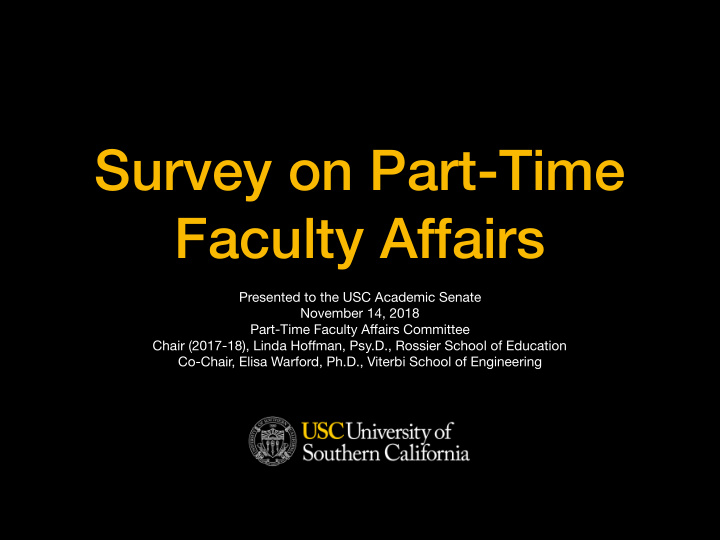



Survey on Part-Time Faculty Affairs Presented to the USC Academic Senate November 14, 2018 Part-Time Faculty A ff airs Committee Chair (2017-18), Linda Ho ff man, Psy.D., Rossier School of Education Co-Chair, Elisa Warford, Ph.D., Viterbi School of Engineering
The purpose of the survey was to gauge compliance with the 2016 Senate Resolution on part-time faculty affairs • Employment profiles, benefits eligibility, and compensation • Evaluation, merit review and promotion • Inclusion in departmental life and governance • Support (will not discuss today)
Employment profiles, benefits, and compensation
Employment profiles: The percentage of “true adjuncts” was only 20% Less than 50% at USC 20% with FT job elsewhere Other employment profiles 36% At least 50% at USC, 15% no other positions 6% 6% 7% 10% Less than 50% at USC, At least 50% at USC with PT, no other job non-teaching job elsewhere Less than 50% at USC Less than 50% at USC with FT and PT, non-teaching job with a PT, non-teaching job elsewhere
Benefits eligibility: 45% of respondents reported being benefits-eligible 33% of the those without other full-time employment had been offered by their schools to bring them up to half-time status Between 78% and 90% of eligible part-time faculty are participating in benefits at any given time
Compensation: Many part-time faculty members reported a discrepancy between the hours allotted in the contract and hours required to do the work “The part time adjunct instructor pay is less than minimum wage after the hours it takes to grade student work on top of class prep and handling students via email/in person mentoring. My contract states 6 hours per week but I often spend 10-15 hours per week. Unacceptable.” “There are some weeks during each semester that I am employed considerably more than 20 hours on work for my class such as grading projects, lecture preparation, etc. Nevertheless, I am required to sign a statement each semester that says I have not exceeded the 50% limit. I sign it because it's expected.”
Evaluation, merit review, and promotion
Evaluation: Most respondents had been evaluated only by student evaluations Percentage of part-time faculty Evaluation method evaluated by this method 55 Student evaluations only 31 Faculty committee Other methods beyond student 14 evaluations
60% of respondents reported not having been informed of evaluation and merit review processes “The three-year review process appears to be very opaque and have a positive or negative outcome. I was asked to submit a document for my review in the beginning of fall '17 and was told that I would be meeting with the Dean to go over the review. I was looking forward to the review and the opportunity to discuss my plans with the Dean. However, I have not received any feedback regarding the review nor met any school faculty or administrator.” “It would be helpful to know how student evaluations of courses can be used to improve instruction and what is defined as exemplary teaching and procedures for merit increases.” “[T]he Dept Chair noted that research shows that university students evaluate women instructors far more critically than male instructors who have identical credentials and skills. There was no attempt to provide any compensation for this known bias….The whole evaluation process seems highly questionable and unfair and I've had no contact with faculty to clarify it or explain.”
Promotion: 74% reported being unaware of promotion paths for PT faculty “I think it would be very beneficial to have concrete information as to how you advance as a part-time lecturer. I have taught at USC for 5 years without a raise in pay or promotion. I do appreciate the flexibility the part time status has allowed but I would be very interested in how to move upwards or seek out pay increases, etc.” “It would be great to know how one can move from part time to full time. It seems to be very mysterious.”
Inclusion in departmental life and shared governance
Departmental meetings: Most part-time faculty had been invited to some departmental meetings 34% Unsure 58% Invited to meetings 8% Not invited
Governance: Most part-time faculty were unaware that they may participate in governance activities Percentage of part-time faculty NOT aware of their eligibility to participate 58% in shared governance Percentage of part-time faculty who have NEVER been involved in shared 74% governance Percentage of part-time faculty who 84% “would” or “might” like to be involved
Not all PT faculty were paid for their service activities 14 of 34 faculty participating in governance had been or were being paid to do so. Only 22% of those who had attended departmental meetings were paid to do so.
Conclusions: Part-time faculty experiences vary widely across schools. However, the survey revealed issues shared broadly across the University: Policy issues: • Discrepancy between hours allotted in contract to perform work and hours required to actually perform the work. • Uneven implementation of policies on evaluation, merit review, and promotion. • Lack of inclusion in shared governance. • Lack of pay for participation in shared governance or other service activities, a clear violation of University policy. Communication issues about all these issues
Recommend
More recommend